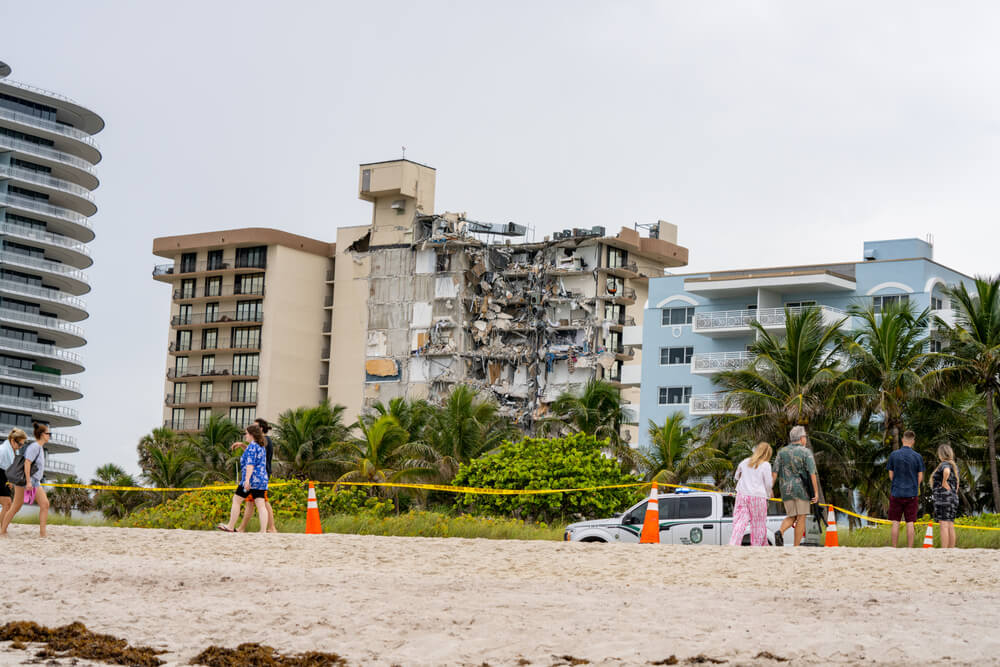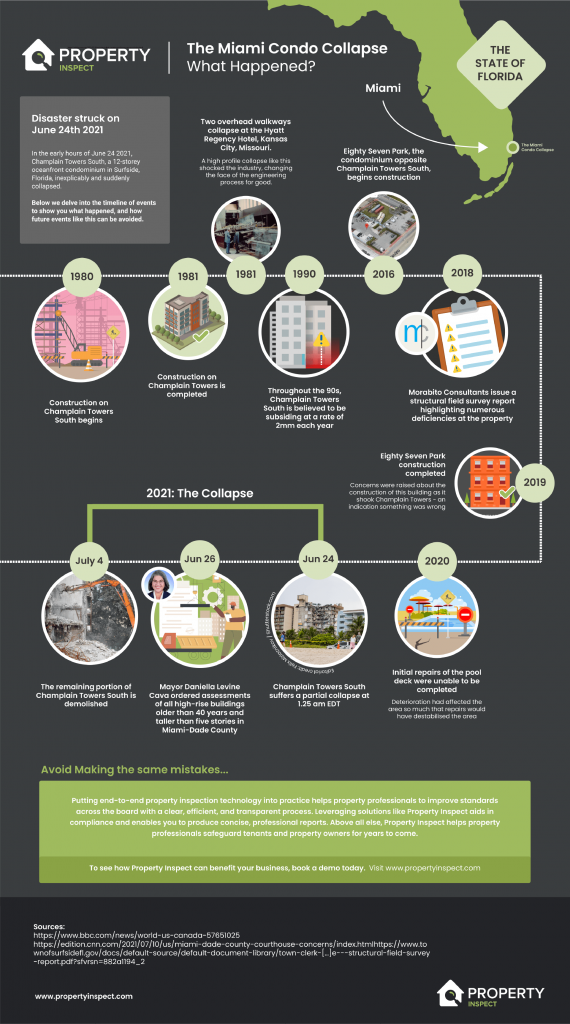Warrick Swift, Commercial Director at Property Inspect, looks at the causes of the Miami condo collapse, what property professionals can learn from this tragic event, and how to eliminate risk in future building inspections.

In the early hours of June 24 2021, Champlain Towers South, a 12-storey oceanfront condominium in Surfside, Florida, inexplicably and suddenly collapsed. The tragedy has claimed the lives of 97 residents, with 8 still unaccounted for, leaving a community reeling and an industry asking itself serious questions.
Although unplanned building collapses of this type are very rare, inspectors across Florida are now rushing out to assess similar condo developments, hoping to prevent further disasters and learn from the failures at Champlain Towers South.
But the collapse, which is believed to have been brought on by years of structural deterioration, has left many asking if there were red flags, and if so, why were they not taken seriously and followed up on?
What caused the Miami collapse?
Statistically speaking, construction and maintenance deficiencies, such as poor renovation, sub-par workmanship, excavation operations, and building deterioration due to poor maintenance, are the most frequent causes of building collapses.
However, at Champlain Towers South, the investigation into the cause of the collapse is still ongoing. Federal investigators are working to determine what happened, though it may take some time to gather all the evidence needed to make an assessment.
In the months leading up to the collapse, residents claimed to hear creaking, some took photographs of cracks appearing around the site, and others felt the building shake. Many events leading up to the collapse will undoubtedly be factored into the investigation; some of them allegedly known to inspectors at the time.
Three years ago, in 2018, a building survey was conducted on Champlain Towers South. It revealed that the ground floor pool deck was an area of concern, highlighting a major error in the design; water pooled on the waterproofing because the deck was not sloped to drain. Reports state that since the 2018 inspection, its condition had deteriorated even further.
The Champlain Towers South condo association board originally commissioned this report on the grounds of a recertification requirement, rather than to address the concerns of its residents. Only two Florida counties have these recertification requirements; Miami-Dade, where Champlain South Towers once stood, is one of them.
A year later, in 2019, condo residents raised concerns over the construction of Eighty Seven Park, an 18-storey apartment block just opposite, saying that they felt significant movement and shaking during the groundworks.
Then in 2020, a study from Florida International University was published. It found that throughout the 1990s, Champlain Towers South was subsiding at a rate of two millimetres per year. The condo was not the sole focus of the study, but it was highlighted as one building experiencing the worst subsidence in the area.
Over the years, diligent residents have raised numerous concerns. Although inspections have been carried out, they’ve failed to address major issues. Was there a flaw in the way the inspections were conducted, was evidence catalogued appropriately, and how were these deficiencies being communicated to the relevant parties?

Quantity of inspections, or quality?
Between January 2018 and August 2019, inspectors visited Champlain Towers South 177 times. Across those 20 months, one engineer, hired by the building’s condominium association, warned of “major structural damage” at the property, as well as cracked concrete beams and walls in the underground garage. Alarmingly, despite the volume of inspections, there has been no record left of a building on the edge of collapse.
Experts believe that compliance with permits on smaller faults and deficiencies, like plumbing or window repair, have ultimately taken precedence over a complete structural review. Individuals in the inspection chain have opted to focus on their particular area of permit compliance, overlooking the greater, more serious structural issues at large.

Speaking to CNN, Eric Glazer, an attorney in South Florida who is set to advise a task force reviewing Florida condominium law, said: “Inspectors love to go to buildings down here when the [unit owner]…installs kitchen cabinets without a permit. But on the way, when they’re walking to that place, if they happen to pass the common elements, and the common elements are literally falling down around them, they’ll ignore it and continue on.”
The number of inspections at Champlain Towers South raises questions about priority, money, and the disjointed nature of building inspections across the state; Florida’s building regulations are notoriously incentivised, with towns and cities collecting fees from permit-related inspections. Property owners are accountable for overall structural safety, not individual permit inspectors.
Growing concern from residents across the state is now spurring calls for reform. Mandatory, statewide inspections and a rethink of the role of government surveyors in structural inspections of buildings are sorely needed, so too is an increase in transparency and a greater emphasis on leveraging technology to speed up reporting and boost efficiency.
What can property professionals learn from this?
After a handful of high profile building collapses in the United States in the 70s and 80s, such as the Kemper Arena and Hyatt Regency collapses in Kansas City, Missouri, the sector looked deeper into its design processes.
Improvements in the way buildings were engineered, constructed, and analysed were made across the board. Yet, after a building is constructed, there is still an ongoing process of inspection to take into account.
One of the core principles to factor into any building inspection is efficiency. The ability for a building inspector to issue instant reports to the right recipients, while documenting and managing a detailed audit trail of all activity for each building or unit, is fundamental to the industry’s success and the prevention of failures such as this.
Managing site visits over a significant period, in real-time, becomes another key factor in building inspections. With a system that keeps live and historical timelines of all events, notifications and property history, property surveyors can hand detailed information off to stakeholders with ease.
This high level of efficiency, which is oftentimes lacking in the industry, due to it being analogue and paper-based, is desperately needed across the sector. Technology provides the key to ensuring standards of transparency, accountability, and accuracy are upheld.
So what can property professionals do to carry out inspections thoroughly? Is there a way in which they can ensure a detailed and transparent inspection, captured and shared with teams across organisations?
What can we do in the future?
Despite the property industry undergoing an unprecedented shift, some property professionals remain steadfast in their methods. The process, for many, is still slow and fragmented, made so by outdated processes and inefficient evidence gathering.
However, in the face of these deep-seated traditional inspection processes, some of the most forward-thinking inspectors are forging ahead with more efficient ways to work. Communal areas, units and multi-family building inspections can be assessed quickly, conveniently, and accurately with technology, allowing for more time to be spent communicating clearly with contractors, internal teams, or cross-organisationally.
While the outcome of the Champlain Towers South investigation is ongoing, the industry must remember to stay ahead of the curve, recognising the value of new software to effectively and accurately manage its inspections.
Putting end-to-end property inspection technology into practice helps property professionals improve standards across the board with a clear, efficient, and transparent process. Leveraging solutions like Property Inspect aids in compliance, enabling you to produce concise, professional reports. Above all else, Property Inspect helps property professionals safeguard tenants and property owners for years to come.
To see how Property Inspect can benefit your business, book a demo today.

